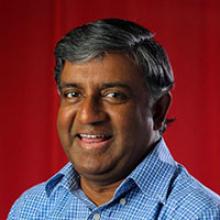Electron Microscopy in Aerospace Alloy Development
Date & Time:
Fri, 10/14/2022 - 1:00pmSpeaker:
Gopal Babu ViswanathanJob title:
Research ProfessorAffiliation:
Dept. of Materials Science and Engineering, Ohio State UniversityLocation:
Discover Park K150Abstract:
Although a great deal of information is known about processing-structure-property relationships in all classes of aerospace Titanium and Ni base superalloys, well-founded predictive models that can be relied upon to estimate the magnitude of potential property variations involving subtle, fine scale changes in microstructure do not exist. A major part of this problem is due to the lack of understanding of the changes to the microstructure occurring at the sub-nanometer level at all levels, from processing of these alloys to their service conditions. Analytical Transmission Electron Microscopy has been pivotal on numerous occasions that has allowed us to decipher the changes to the microstructure that are critical to the designers of the components used in the aerospace industry. This talk is mainly focused on the use of analytical microscopy techniques that made singular differences to the understanding of basic mechanisms in the development of Titanium and Ni-base superalloys both past and present. On the Titanium side, the evolution as well as the defect accumulation in the α and β phases, the two major constituent phases that make up the microstructure, will be examined. On the Ni-base superalloys side, the evolution of γ' phase within the γ matrix and the defect accumulation within will be discussed. In both cases, the nature and role of the phase boundaries will be discussed. Finally, structural and compositional instabilities on microstructural evolution during environmentally accelerated damage process in disk Ni base superalloys will be addressed.

Biography:
Dr. Viswanathan is currently a Research Professor in the MSE department at The Ohio State University, Columbus, Ohio. Prior to joining MSE, he worked as Senior Research scientist at UES/ Air Force research Laboratory, Wright-Patterson Air Force Base, Dayton Ohio. Dr. Viswanathan has considerable research experience, both experimental and theoretical in the area of structure/property relationship in structural and energy materials. Specifically, He has initiated and conducted research, both independent and collaborative, in the advancement of Titanium, Nickel and Iron based alloys, intermetallics and High Entropy Alloys. He has decades of experience in analytical electron microscopy techniques in the areas of diffraction, Hi-Resolution Microscopy, HAADF-STEM microscopy and EDS/EELS ans X-Ray spectroscopy and image simulation methods such as defect simulation and electron-exit-wave image reconstruction techniques for his research. His also includes the use of additive manufacturing methods for the development of Ti, Ni and compositionally complex alloy (CCA) systems. His collaborative research partners include government agencies DOE and AFOSR and industries such as Rolls-Royce, Ge , Pratt & Whitney, DNV GL, Chevron and Exxon.
Seminar ID:
202210141300Department:
Materials Science and Engineering